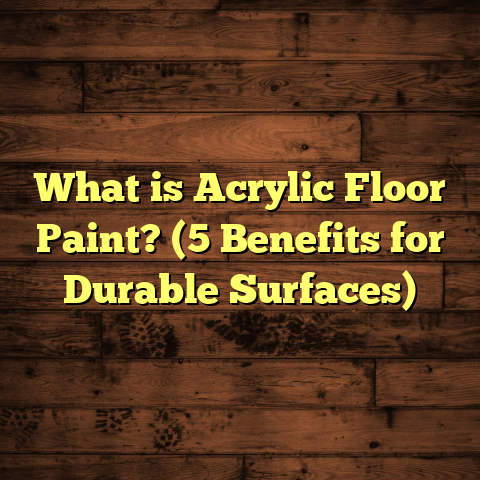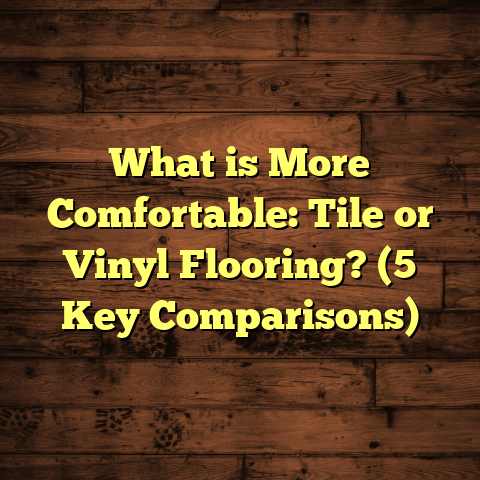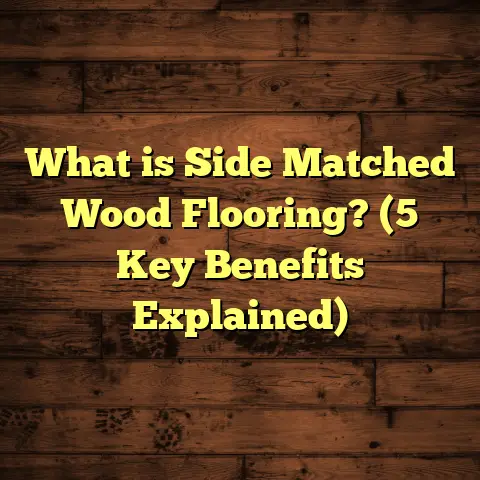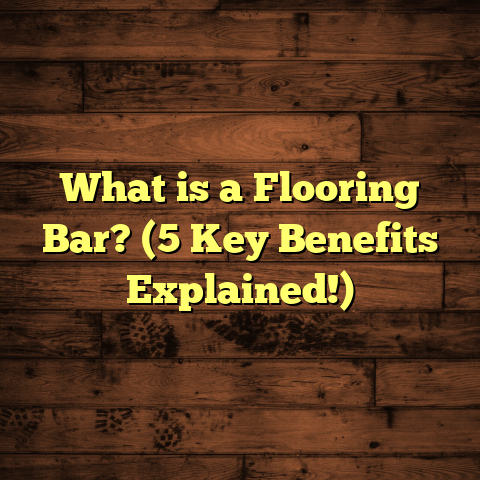What is Engineered Wood Flooring Made Of? (5 Key Components Revealed!)
Investing in flooring is one of the smartest moves you can make for your home. After all, a floor isn’t just something you walk on—it sets the tone for every room and can add real value to your property. When I first started working with wood floors, engineered wood caught my attention because it offers a beautiful hardwood look but with some clever construction benefits that make it more stable and versatile. So, what exactly is engineered wood flooring made of? Let me walk you through the five key components that make this flooring option stand out.
What Is Engineered Wood Flooring Made Of?
Engineered wood flooring is a layered product designed to give you the rich appearance of solid hardwood but with improved durability and flexibility. Unlike solid hardwood, which is a single piece of wood throughout, engineered wood consists of multiple layers of wood veneer stacked together.
At its core, engineered wood flooring combines these layers in a way that enhances strength and minimizes issues like warping or shrinking when exposed to moisture or changes in temperature. This construction technique allows it to perform better in places where solid hardwood might struggle, such as basements or over radiant heating systems.
Now, let’s break down those five essential components that make engineered wood what it is.
1. The Top Layer: Hardwood Veneer
The top layer is the part you actually see and walk on—it’s a thin slice of real hardwood, usually about 1/16 to 1/8 inch thick. This veneer gives engineered wood its authentic hardwood look and feel.
Common species for the veneer include oak, maple, walnut, hickory, and cherry. The thickness of this layer determines how many times the floor can be sanded and refinished over its lifetime. For example, a thicker veneer means you can sand off scratches and dents multiple times, extending the life of your floor.
When I installed a walnut engineered floor in a client’s home last year, the beauty of the top grain really impressed them. They loved that it had the same warmth and character as solid wood but was more adaptable to their home’s humidity levels.
If you’re wondering how thick the veneer should be for your project, here’s a quick guide based on what I’ve seen work best:
- 1/16 inch (approx. 1.5 mm): Usually found in thinner engineered planks. Can be sanded once or twice.
- 3/32 inch (approx. 2.5 mm): More common middle range thickness; can handle sanding 2-3 times.
- 1/8 inch (approx. 3 mm) or thicker: Best durability and refinishing potential; can be sanded multiple times like solid hardwood.
One thing I always tell homeowners is to check the veneer thickness before buying engineered wood because it affects how long your floor will last and how often you can refresh it with sanding.
2. The Core Layers: Plywood or HDF (High-Density Fiberboard)
Beneath the top veneer are several layers that form the core of the flooring plank. These layers are usually made from plywood or high-density fiberboard (HDF). The core is what gives engineered wood its strength and dimensional stability.
Plywood cores are made by gluing together thin sheets of wood veneers in alternating grain directions, which helps resist expansion and contraction. HDF cores are made from compressed wood fibers and resin, offering an extremely dense and hard base.
In my experience, plywood cores tend to be more resilient to moisture, while HDF cores provide a smoother surface for the veneer and are often used in thinner engineered floors.
Here’s a little story: Once, a client wanted engineered floors installed in their basement, which had some occasional moisture issues despite good waterproofing. We went with plywood-core engineered wood because plywood’s cross-layered construction offers better resistance to moisture-related warping compared to HDF. Two years later, their floor still looked perfect without any cupping or gaps.
The number of core layers also matters. Many engineered planks have anywhere from three to nine layers stacked together. More layers generally mean better stability but can also increase cost.
For example:
| Number of Core Layers | Stability Level | Typical Use Cases |
|---|---|---|
| 3-5 | Moderate | Residential living rooms, bedrooms |
| 6-9 | High | Commercial spaces, kitchens, basements |
3. The Backing Layer
The bottom layer of engineered wood flooring, called the backing layer, adds balance and support to the plank. It’s usually made from plywood or some other type of composite material.
This layer helps counteract the stresses from the top layers and prevents the plank from bending or twisting. It also provides additional moisture resistance. When I laid engineered floors over concrete slabs, this backing layer was essential in reducing potential warping caused by moisture coming from below.
The backing layer is often overlooked but plays a big role in keeping your floor flat and stable over many years.
In terms of thickness, backing layers tend to be thinner than core layers but are dense enough to support the entire plank structure. Without this foundation, you’d likely see more gaps or cupping develop over time as natural forces work against your floor.
4. Adhesives and Glues
The layers in engineered wood flooring are bonded together with strong adhesives that are designed to hold up under pressure and temperature changes without breaking down.
Modern adhesives are often formaldehyde-free or low in volatile organic compounds (VOCs), which is important if you or your family are sensitive to indoor air quality.
I remember a project where the client was particularly concerned about chemical emissions. We chose an engineered product with a no-added-formaldehyde glue, which gave them peace of mind without sacrificing durability.
Adhesives not only hold layers together but also contribute to dimensional stability by preventing delamination—the separation of layers that ruins a floor’s performance.
Manufacturers typically use a combination of hot press adhesive bonding with resins designed specifically for engineered flooring. This process ensures planks remain stable even with seasonal humidity swings.
5. Finishes and Coatings
Once constructed, engineered wood floors are coated with protective finishes that guard against scratches, stains, and wear.
These finishes can be oil-based polyurethane, water-based polyurethane, aluminum oxide, or UV-cured coatings. The type of finish affects not only durability but also the appearance—some finishes give a matte look while others add shine.
I’ve found that UV-cured finishes offer excellent resistance to wear and tear while maintaining a natural look, making them a popular choice for high-traffic areas.
Finishes do more than just protect; they also enhance color and texture. For example:
- Oil-based polyurethanes tend to deepen wood tones over time but take longer to dry and emit stronger VOCs during application.
- Water-based polyurethanes dry quickly with low odor but may not add as much amber hue.
- Aluminum oxide coatings are extremely hard-wearing and common on prefinished planks.
- UV-cured finishes cure instantly under ultraviolet light at the factory, producing tough surfaces that resist scratching for years.
One interesting fact: According to research by the National Wood Flooring Association (NWFA), floors finished with aluminum oxide coatings can last up to 25 years with minimal visible wear in residential settings—much longer than traditional finishes.
How Does Engineered Wood Flooring Perform in Real Life?
With these components working together, engineered wood flooring offers several practical advantages:
- Better Stability: Thanks to its layered construction, it handles moisture changes better than solid hardwood. This makes it suitable for basements or kitchens where humidity levels fluctuate.
- Installation Flexibility: You can install engineered wood using different methods—floating floors that click together, glue-down methods on concrete slabs, or traditional nail-down installation over wooden subfloors.
- Appearance: Since the top layer is real hardwood, you get all the natural beauty without some of the downsides like cupping or cracking.
Speaking of installation, I recently worked on a renovation where we installed an oak engineered floor over radiant heat tubing. Solid hardwood would have been risky due to expansion issues, but engineered floors handled it perfectly without any problems after two years.
Here’s a deeper look at these benefits:
Stability Under Changing Conditions
One of the biggest complaints I hear about solid hardwood is how it reacts when seasons change—boards expand in summer and shrink in winter causing gaps or buckling.
Engineered wood’s cross-layered design dramatically reduces this movement by distributing stresses evenly across plies oriented in alternating directions.
According to tests done by flooring industry labs:
- Engineered wood experiences approximately 30%-50% less dimensional change than equivalent solid hardwood under varying humidity conditions.
That means fewer worries about squeaky floors or unsightly gaps after winter heating or summer humidity spikes.
Installation Versatility
Another reason I recommend engineered wood is how adaptable it is during installation:
- Floating Floors: Many engineered planks come with click-lock systems allowing them to “float” above subfloor without glue or nails. This reduces installation time and makes replacement easier later on.
- Glue-Down: When installing over concrete slabs or radiant heating systems where nailing isn’t possible, glue-down works well for a solid feel.
- Nail/Staple Down: If you have wooden subfloors like plywood or OSB boards beneath, nailing down engineered floors offers excellent stability mimicking traditional hardwood installations.
For DIYers new to flooring projects, floating installations are often easiest; professionals prefer glue-down or nail-down for longevity in certain applications.
Appearance and Hardwood Authenticity
Since the surface veneer is real hardwood, you get all the visual benefits solid wood offers—grain patterns, color variations, natural knots—that laminate or vinyl simply can’t replicate perfectly.
One homeowner told me their guests often ask if their floor was solid hardwood because it looks so natural—even after years of daily use with kids running around!
What About Installation? Tips From My Experience
Installing engineered wood flooring involves some preparation but can be straightforward if you follow these steps closely:
Acclimate Your Flooring
Before installation starts, bring your new planks into the room where they’ll be installed for at least 48 hours—or longer if possible—to acclimate them to local temperature and humidity levels.
Skipping this step can cause excessive expansion or contraction after installation leading to gaps or buckling later on.
I had one client who skipped acclimation because they were eager to finish quickly; within weeks small gaps appeared around edges that required filler and reinstallation work—costly mistake avoided by simple acclimation!
Prepare Your Subfloor
The subfloor must be clean, dry, level (within 3/16 inch over 10 feet), and free from debris before laying any flooring material.
Uneven subfloors cause rocking planks or premature damage due to uneven pressure points.
In one project where we discovered unevenness late in installation, we had to stop work mid-way and apply leveling compound—lesson learned: always measure subfloor flatness early!
Choose Installation Method Wisely
Your subfloor type influences installation choice:
- Concrete slabs usually require glue-down or floating floors with moisture barriers underneath.
- Wooden subfloors allow nail-down or floating installation depending on preference.
Floors using floating installation allow quicker repairs later but may feel slightly less solid underfoot compared to nailed floors—which some clients prefer for large open living areas.
Use Proper Tools And Techniques
Using tools like tapping blocks helps fit planks snugly without damaging edges during installation.
Flooring nailers speed up nailing jobs while maintaining consistent pressure preventing plank damage.
I remember working on a stair landing once where precise cuts and gentle tapping were critical—using proper tools made all difference between tight seams and visible gaps around corners!
Maintaining Engineered Wood Flooring: My Personal Advice
Maintaining your engineered wood floor properly keeps it looking great for decades:
Regular Cleaning
Sweep or vacuum regularly using soft brush attachments to avoid scratching surfaces with dirt particles.
Avoid vacuums with beater bars that can cause micro-scratches over time.
Damp Mopping
Use damp (not wet) microfiber mops with cleaners specifically formulated for wood floors—never harsh chemicals or abrasive scrubbers that can strip finishes away.
I always recommend products approved by flooring manufacturers since they maintain finish integrity better than general household cleaners.
Protect High-Traffic Areas
Place area rugs at entrances and under furniture legs to reduce wear spots from heavy foot traffic and chair movements.
Using felt pads under furniture legs prevents dents when moving heavy items around rooms—a simple tip my clients always appreciate!
Refinishing Potential
Depending on your floor’s veneer thickness (we talked about this earlier), you might be able to sand and refinish your floor every 7-10 years for several cycles throughout its life—refreshing color and removing surface wear marks without needing full replacement.
One client called me after eight years complaining about minor scratches; after sanding and recoating their engineered floor looked brand new again—prolonging their investment significantly!
Cost Considerations: How I Plan Flooring Budgets Using FloorTally
Budgeting for new floors can get complicated fast when you factor materials, labor costs based on location, waste factor from cutting patterns, finish types, underlayment needs—the list goes on.
I rely on FloorTally whenever I plan projects because it consolidates all those variables into one easy-to-understand estimate based on local market prices for materials and labor rates specific to my area.
This tool helps me:
- Calculate square footage accurately including waste factors (usually 5%-10% extra material)
- Compare costs between different materials/species/styles quickly
- Factor in labor costs based on installation type (floating vs glue-down vs nail-down)
- Visualize total project cost upfront helping clients avoid surprises during purchase
Using FloorTally streamlines my workflow dramatically—no more juggling spreadsheets or chasing multiple quotes—and helps clients make informed decisions aligned with their budgets without compromising quality choices.
If you’re planning a flooring project yourself or working with contractors who provide quotes that seem unclear or inconsistent, try plugging numbers into FloorTally for clearer insight before committing financially—it saved me headaches countless times!
What Makes Engineered Wood Flooring Special?
Here are some data points that highlight why I recommend engineered wood frequently:
- Stability: Engineered floors show 30%-50% less expansion/contraction compared to solid hardwood under humidity changes (source: National Wood Flooring Association).
- Installation Speed: Professionals report floating installations can be completed up to 40% faster than traditional solid hardwood nailing methods (source: Flooring Industry Reports).
- Environmental Impact: Engineered wood uses less slow-growing hardwood since only the thin veneer is actual hardwood; core layers use faster-growing woods or recycled materials—a win for sustainability-minded consumers.
I’ve seen clients appreciate both its beauty and practicality—especially families with kids or pets who want durable flooring without sacrificing style.
Engineered Wood Flooring vs Other Flooring Types
If you’re still weighing options between laminate, vinyl plank flooring (LVP), solid hardwood, or engineered wood—here’s how engineered stands out:
| Feature | Engineered Wood | Solid Hardwood | Laminate | Luxury Vinyl Plank (LVP) |
|---|---|---|---|---|
| Real Wood Surface | Yes (veneer) | Yes | No | No |
| Moisture Resistance | Moderate | Low | High | Very High |
| Installation Options | Floating / Glue / Nail | Nail / Staple | Floating | Floating |
| Cost per sq ft | $4 – $10 | $7 – $15+ | $1 – $4 | $2 – $7 |
| Refinishing Possible | Yes (depending on veneer) | Yes | No | No |
| Durability | High | High | Moderate | High |
I’ve helped many clients choose based on lifestyle needs:
- Families with kids/pets love engineered because it balances durability with warmth better than laminate while being easier maintenance than solid hardwood in tricky rooms like kitchens or basements.
- Renovators working over concrete slabs prefer engineered due to easy glue-down options not available with solid hardwood.
Final Thoughts From My Flooring Journey
Working hands-on with dozens of flooring projects over years has taught me that engineered wood offers an impressive combination of natural beauty and smart engineering solutions.
It adapts well across different environments—from humid basements to heated living rooms—without sacrificing aesthetics or comfort underfoot. Plus its structured layers mean less worry about cracking or warping common with traditional hardwoods in challenging conditions.
If you’re considering new floors for your home but want something that will last while offering flexibility in installation methods and design options—engineered wood might just be your best bet.
Have questions about specific species options? Curious about best ways to maintain your floors? Or need help estimating materials for your upcoming project? Just ask—I’m happy to share what I’ve learned through years of hands-on experience!
This article aimed to give you a comprehensive understanding of what goes into engineered wood floors so you can make informed decisions whether you’re buying new flooring or planning an installation project soon. The five components—the top hardwood veneer, core layers (plywood/HDF), backing layer, adhesives used in bonding layers, and protective finishes—all combine thoughtfully for a high-performance product designed for modern homes today.
If you want help figuring out costs tailored specifically for your space before committing financially, tools like FloorTally can save you time by consolidating all those variables into one simple estimate—something I use regularly myself!
Thanks for spending time learning alongside me today—I hope this information makes your flooring project easier!





